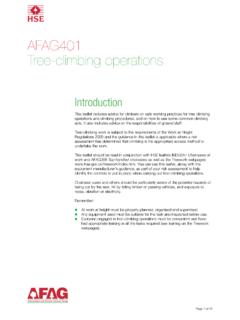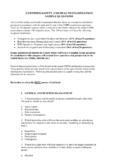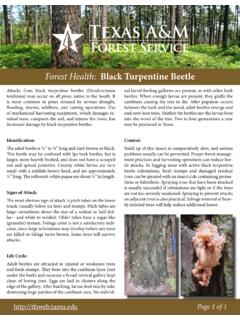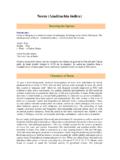Transcription of RECOGNIZING TREE DISEASES AND STRESS FACTORS
1 Dr. Sharon M. Douglas Department of Plant Pathology and Ecology The Connecticut Agricultural Experiment Station 123 Huntington Street, P. O. Box 1106 New Haven, CT 06504 Phone: (203) 974-8601 Fax: (203) 974-8502 Email: RECOGNIZING tree DISEASES AND STRESS FACTORS tree health problems in Connecticut are associated with a number of abiotic and biotic FACTORS . I. STEPS FOR disease PREVENTION AND CONTROL: A. Diagnosis- knowing what you're trying to control; accurate diagnosis is critical for successful disease control; B. Assessing the Severity of the problem - 1. Nature of pest problem - type of disease , , root vs.
2 Foliar, systemic vs. localized 2. Level of disease - loss threshold, , amount of disease , number of years with problem ; number of trees affected C. Control Options- 1. Culture: this includes cultural methods that modify the plant's growing conditions; maintaining optimum plant vigor by proper site selection, proper watering and fertilizing; avoiding mechanical injuries and soil compaction; appropriately timed pruning and transplanting, adequate spacing between plants, improving tilth and pH of the soil; 2. Sanitation: this involves the use of vigorous, healthy, disease -free cuttings or plants, pruning of affected plant parts; raking and removing affected plant parts such as fallen leaves; disinfesting tools such as pruning shears and spades; 3.
3 Resistance: this involves the use of resistant/tolerant cultivars; plants with genetic resistance to specific DISEASES ; refer to lists of cultivars with specific types of resistance; 4. Chemical: this involves the use of pesticides which are registered for control of specific DISEASES ; proper selection and timing of pesticide applications are very important; it is also very important to thoroughly read the pesticide label; the current status of many fungicides is unstable and labels are frequently being modified; II. COMMON PLANT HEALTH PROBLEMS: A. Abiotic (caused by non-living agents) 1.
4 Culture 2. Environment B. Biotic (caused by living agents) 2 1. Fungi 2. Bacteria, MLOs 3. Viruses 4. Nematodes III. FACTORS TO CONSIDER IN PLANT SELECTION: "The right plant for the right site!" A. Hardiness B. Site Requirements vs. Site Characteristics C. Structure/Size of Root System D. Aesthetic Qualities E. Sensitivities F. Common disease Problems IV. COMMON ABIOTIC PROBLEMS: A. Winter Injury- 1. Symptoms: dieback, foliar browning, sunscald and bark splitting 2. Causal FACTORS : late spring frosts (after growth has started), cool summer followed by a warm fall and drop in temperature, excessive or late season nitrogen fertilization, dry soil or root injury, frost cracking, excessive temperature fluctuations and drying winds, lack of snowcover 3.
5 Commonly Affected Plants: wide range of plants including broadleaved evergreens (rhododendron and mountain laurel), narrowleaved evergreens (arborvitae, yew, juniper, pine, and hemlock), deciduous trees and shrubs (weeping cherry, rose), and ground covers (pachysandra and ivy) 4. Control Measures: a. select appropriate site for planting b. have sufficient moisture in root zone before soil freezes c. avoid late summer and early fall fertilization d. mulch to increase moisture retention in winter e.
6 Prune out dead branches or twigs in spring and fertilize to stimulate new growth f. use of anti-transpirants or anti-desiccants B. Drought- 1. Symptoms: loss of turgor in needles or leaves, drooping, wilting, yellowing, premature leaf or needle drop, dieback, poor growth, stunting, plant death; predisposes plant to secondary problems and cultural injuries; symptoms often not evident until the year after drought occurs 2. Causal FACTORS : soil water becomes deficient and results in feeder root damage and death; plant unable to take up water 3.
7 Commonly Affected Plants: 3 broad range of deciduous and evergreen trees and shrubs; effects are particularly severe on seedlings or recent transplants but established plants are also affected; especially affected this year were maple, ash, hemlock, juniper, dogwood, rhododendron 4. Control Measures: a. water in periods of low soil moisture b. select appropriate site and use proper planting practices c. select native plants adapted to local seasonal and annual variations in the water supply; drought sensitive ( , dogwood, many oaks, arborvitae, many Viburnum) vs drought tolerant species ( , most pines, many Prunus, eastern larch, some junipers) d.
8 Prune out dead branches or twigs in spring C. Excess Water- 1. Symptoms: highly variable, including epinasty (downward bending of petioles), stem swelling, chlorosis, edema, reduced and stunted growth, twig dieback, wilting, leaf drop, root and plant death 2. Causal FACTORS : root damage in flooded or waterlogged soils associated with oxygen deficiency; damaged fibrous roots die, decay, and plants are unable to take up water; predisposed plants are subject to secondary invaders and opportunistic pests 3. Commonly Affected Plants: seedlings and new transplants are more sensitive than established ones; dormant plants tolerate flooding longer than those in active growth; angiosperms are generally thought to be more tolerant than gymnosperms; particularly affected are yews, hemlocks, maples, rhododendrons 4.
9 Control Measures: a. avoid plant STRESS by appropriate site selection and proper planting practices b. maintain vigor by fertilization to stimulate good growth c. select appropriate species for site and soil conditions, water tolerant species ( , red maple, eastern larch, forsythia, green ash) vs water intolerant species ( , gray and paper birch, crabapple, dogwood, eastern hemlock) d. prune dead or dying tissues to minimize problems from secondary invaders D. Air Pollution- 1. Symptoms: highly variable, depending upon type of pollutant and plant host; typically classified as acute or chronic; acute injury normally involves the death of cells and develops within a few hours or days following exposure to high levels of pollutants; symptoms include stippling or altered pigmentation, flecking, bleaching, chlorosis, interveinal and marginal necrosis, and tip necrosis; chronic injury typically develops more slowly, within days or weeks following exposure; this type of injury usually appears in response to long-term, low-concentration exposure.
10 In some cases, visible symptoms are not present but exposure results in suppressed photosynthesis rates, stimulated respiration, and suppressed growth; 4 symptoms are often subtle and easily confused with other problems such as normal senescence, nutritional disorders or other environmental stresses 2. Causal FACTORS : major classes of phytotoxic air pollutants, in descending order of direct damage are: oxidants (ozone O3, PAN), sulfur dioxide (SO3), and fluorides (hydrogen fluorides HF) 3. Commonly Affected Plants: significant differences in sensitivity of plant species to specific pollutants occur; particularly sensitive tree species to specific pollutants are: O3- white ash, eastern white pine, black cherry, catalpa, honey locust SO3- larch, birch, American elm, eastern white pine HF- young, expanding needles of pines and spruces, paulownia, Douglas fir, serviceberry 4.

















